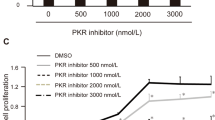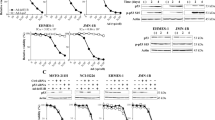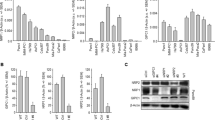Abstract
Both inhibitor of growth 4 (ING4) and phosphatase and tensin homolog (PTEN) have been shown to be strong candidate tumor suppressors. However, the combined efficacy of ING4 and PTEN for human gastric cancer remains to be determined. In this report, we constructed a multiple promoter expression cassette-based recombinant adenovirus coexpressing ING4 and PTEN (AdVING4/PTEN), assessed the combined effects of AdVING4/PTEN on gastric cancer using wild-type p53 AGS and SNU-1 human gastric cancer cell lines, and elucidated its underlying mechanisms. We found that AdVING4/PTEN-induced synergistic growth inhibition and apoptosis in vitro AGS or SNU-1 tumor cells and in vivo AGS xenografted tumors subcutaneously inoculated in athymic BALB/c nude mice. Mechanistically, AdVING4/PTEN exhibited an enhanced effect on upregulation of p53, Ac-p53 (K382), P21, Bax, PUMA, Noxa, cleaved Caspase-9, cleaved Caspase-3 and cleaved PARP as well as downregulation of Bcl-2 in vitro and in vivo. In addition, AdVING4/PTEN synergistically downregulated tumor vessel CD34 expression and reduced microvessel density, and additively inhibited vascular endothelial growth factor (VEGF) expression in vivo. The synergistic tumor suppression elicited by AdVING4/PTEN was closely associated with the synergistic induction of apoptosis possibly via enhancement of endogenous p53 responses through cooperatively facilitating p53’s stability and acetylation, and the synergistic inhibition of tumor angiogenesis probably via overlapping reduction of VEGF through cooperatively downregulating hypoxia inducible factor-1α’s level and transcription activity. Thus, our results indicate that cancer gene therapy combining ING4 and PTEN may constitute a novel and effective therapeutic modality for human gastric cancer and other cancers.
This is a preview of subscription content, access via your institution
Access options
Subscribe to this journal
Receive 12 print issues and online access
$259.00 per year
only $21.58 per issue
Buy this article
- Purchase on Springer Link
- Instant access to full article PDF
Prices may be subject to local taxes which are calculated during checkout






Similar content being viewed by others
References
Tallen G, Riabowol K . Keep-ING balance: tumor suppression by epigenetic regulation. FEBS Lett 2014; 588: 2728–2742.
Shiseki M, Nagashima M, Pedeux RM, Kitahama-Shiseki M, Miura K, Okamura S et al. p29ING4 and p28ING5 bind to p53 and p300, and enhance p53 activity. Cancer Res 2003; 63: 2373–2378.
Unoki M, Shen JC, Zheng ZM, Harris CC . Novel splice variants of ING4 and their possible roles in the regulation of cell growth and motility. J Biol Chem 2006; 281: 34677–34686.
Xie Y, Zhang H, Sheng W, Xiang J, Ye Z, Yang J . Adenovirus-mediated ING4 expression suppresses lung carcinoma cell growth via induction of cell cycle alteration and apoptosis and inhibition of tumor invasion and angiogenesis. Cancer Lett 2008; 271: 105–116.
Gong A, Ye S, Xiong E, Guo W, Zhang Y, Peng W et al. Autophagy contributes to ING4-induced glioma cell death. Exp Cell Res 2013; 319: 1714–1723.
Kim S, Chin K, Gray JW, Bishop JM . A screen for genes that suppress loss of contact inhibition: identification of ING4 as a candidate tumor suppressor gene in human cancer. Proc Natl Acad Sci USA 2004; 101: 16251–16256.
Shen JC, Unoki M, Ythier D, Duperray A, Varticovski L, Kumamoto K et al. Inhibitor of growth 4 suppresses cell spreading and cell migration by interacting with a novel binding partner, liprin alpha1. Cancer Res 2007; 67: 2552–2558.
Li J, Martinka M, Li G . Role of ING4 in human melanoma cell migration, invasion and patient survival. Carcinogenesis 2008; 29: 1373–1379.
Garkavtsev I, Kozin SV, Chernova O, Xu L, Winkler F, Brown E et al. The candidate tumour suppressor protein ING4 regulates brain tumour growth and angiogenesis. Nature 2004; 428: 328–332.
Nozell S, Laver T, Moseley D, Nowoslawski L, De Vos M, Atkinson GP et al. The ING4 tumor suppressor attenuates NF-kappaB activity at the promoters of target genes. Mol Cell Biol 2008; 28: 6632–6645.
Ozer A, Wu LC, Bruick RK . The candidate tumor suppressor ING4 represses activation of the hypoxia inducible factor (HIF). Proc Natl Acad Sci USA 2005; 102: 7481–7486.
Colla S, Tagliaferri S, Morandi F, Lunghi P, Donofrio G, Martorana D et al. The new tumor-suppressor gene inhibitor of growth family member 4 (ING4) regulates the production of proangiogenic molecules by myeloma cells and suppresses hypoxia-inducible factor-1 alpha (HIF-1alpha) activity: involvement in myeloma-induced angiogenesis. Blood 2007; 110: 4464–4475.
Hou Y, Zhang Z, Xu Q, Wang H, Xu Y, Chen K . Inhibitor of growth 4 induces NFkappaB/p65 ubiquitin-dependent degradation. Oncogene 2013; 33: 1997–2003.
Lu M, Pan C, Zhang L, Ding C, Chen F, Wang Q et al. ING4 inhibits the translation of proto-oncogene MYC by interacting with AUF1. FEBS Lett 2013; 587: 1597–1604.
Song MS, Salmena L, Pandolfi PP . The functions and regulation of the PTEN tumour suppressor. Nat Rev Mol Cell Biol 2012; 13: 283–296.
Li DM, Sun H . PTEN/MMAC1/TEP1 suppresses the tumorigenicity and induces G1 cell cycle arrest in human glioblastoma cells. Proc Natl Acad Sci U S A 1998; 95: 15406–15411.
Saito Y, Swanson X, Mhashilkar AM, Oida Y, Schrock R, Branch CD et al. Adenovirus-mediated transfer of the PTEN gene inhibits human colorectal cancer growth in vitro and in vivo. Gene Ther 2003; 10: 1961–1969.
Jin H, Xu CX, Kim HW, Chung YS, Shin JY, Chang SH et al. Urocanic acid-modified chitosan-mediated PTEN delivery via aerosol suppressed lung tumorigenesis in K-ras(LA1) mice. Cancer Gene Ther 2008; 15: 275–283.
Garcia-Cao I, Song MS, Hobbs RM, Laurent G, Giorgi C, de Boer VC et al. Systemic elevation of PTEN induces a tumor-suppressive metabolic state. Cell 2012; 149: 49–62.
Tamura M, Gu J, Takino T, Yamada KM . Tumor suppressor PTEN inhibition of cell invasion, migration, and growth: differential involvement of focal adhesion kinase and p130Cas. Cancer Res 1999; 59: 442–449.
Zhang LL, Liu J, Lei S, Zhang J, Zhou W, Yu HG . PTEN inhibits the invasion and metastasis of gastric cancer via downregulation of FAK expression. Cell Signal 2014; 26: 1011–1020.
Schneider E, Keppler R, Prawitt D, Steinwender C, Roos FC, Thuroff JW et al. Migration of renal tumor cells depends on dephosphorylation of Shc by PTEN. Int J Oncol 2011; 38: 823–831.
Chetram MA, Odero-Marah V, Hinton CV . Loss of PTEN permits CXCR4-mediated tumorigenesis through ERK1/2 in prostate cancer cells. Mol Cancer Res 2011; 9: 90–102.
Hwang PH, Yi HK, Kim DS, Nam SY, Kim JS, Lee DY . Suppression of tumorigenicity and metastasis in B16F10 cells by PTEN/MMAC1/TEP1 gene. Cancer Lett 2001; 172: 83–91.
Song MS, Carracedo A, Salmena L, Song SJ, Egia A, Malumbres M et al. Nuclear PTEN regulates the APC-CDH1 tumor-suppressive complex in a phosphatase-independent manner. Cell 2011; 144: 187–199.
Trimboli AJ, Cantemir-Stone CZ, Li F, Wallace JA, Merchant A, Creasap N et al. Pten in stromal fibroblasts suppresses mammary epithelial tumours. Nature 2009; 461: 1084–1091.
Hopkins BD, Fine B, Steinbach N, Dendy M, Rapp Z, Shaw J et al. A secreted PTEN phosphatase that enters cells to alter signaling and survival. Science 2013; 341: 399–402.
Putz U, Howitt J, Doan A, Goh CP, Low LH, Silke J et al. The tumor suppressor PTEN is exported in exosomes and has phosphatase activity in recipient cells. Sci Signal 2012; 5: ra70.
Jemal A, Bray F, Center MM, Ferlay J, Ward E, Forman D . Global cancer statistics. CA Cancer J Clin 2011; 61: 69–90.
Wilson DR . Viral-mediated gene transfer for cancer treatment. Curr Pharm Biotechnol 2002; 3: 151–164.
Brenner MK, Gottschalk S, Leen AM, Vera JF . Is cancer gene therapy an empty suit? Lancet Oncol 2013; 14: e447–e456.
Xie Y, Lv H, Sheng W, Miao J, Xiang J, Yang J . Synergistic tumor suppression by adenovirus-mediated inhibitor of growth 4 and interleukin-24 gene cotransfer in hepatocarcinoma cells. Cancer Biother Radiopharm 2011; 26: 681–695.
Zhu Y, Lv H, Xie Y, Sheng W, Xiang J, Yang J . Enhanced tumor suppression by an ING4/IL-24 bicistronic adenovirus-mediated gene cotransfer in human non-small cell lung cancer cells. Cancer Gene Ther 2011; 18: 627–636.
Byun DS, Cho K, Ryu BK, Lee MG, Park JI, Chae KS et al. Frequent monoallelic deletion of PTEN and its reciprocal associatioin with PIK3CA amplification in gastric carcinoma. Int J Cancer 2003; 104: 318–327.
Liu Y, Ye T, Sun D, Maynard J, Deisseroth A . Conditionally replication-competent adenoviral vectors with enhanced infectivity for use in gene therapy of melanoma. Hum Gene Ther 2004; 15: 637–647.
He TC, Zhou S, da Costa LT, Yu J, Kinzler KW, Vogelstein B . A simplified system for generating recombinant adenoviruses. Proc Natl Acad Sci USA 1998; 95: 2509–2514.
Weidner N . Current pathologic methods for measuring intratumoral microvessel density within breast carcinoma and other solid tumors. Breast Cancer Res Treat 1995; 36: 169–180.
Wang W, Qin SK, Chen BA, Chen HY . Experimental study on antitumor effect of arsenic trioxide in combination with cisplatin or doxorubicin on hepatocellular carcinoma. World J Gastroenterol 2001; 7: 702–705.
Zhang X, Zhu W, Zhang J, Huo S, Zhou L, Gu Z et al. MicroRNA-650 targets ING4 to promote gastric cancer tumorigenicity. Biochem Biophys Res Commun 2010; 395: 275–280.
Ryan HE, Lo J, Johnson RS . HIF-1 alpha is required for solid tumor formation and embryonic vascularization. EMBO J 1998; 17: 3005–3015.
Ferrara N . VEGF and the quest for tumour angiogenesis factors. Nat Rev Cancer 2002; 2: 795–803.
Kandoth C, McLellan MD, Vandin F, Ye K, Niu B, Lu C et al. Mutational landscape and significance across 12 major cancer types. Nature 2013; 502: 333–339.
Cheok CF, Verma CS, Baselga J, Lane DP . Translating p53 into the clinic. Nat Rev Clin Oncol 2011; 8: 25–37.
Freeman DJ, Li AG, Wei G, Li HH, Kertesz N, Lesche R et al. PTEN tumor suppressor regulates p53 protein levels and activity through phosphatase-dependent and -independent mechanisms. Cancer Cell 2003; 3: 117–130.
Mayo LD, Donner DB . A phosphatidylinositol 3-kinase/Akt pathway promotes translocation of Mdm2 from the cytoplasm to the nucleus. Proc Natl Acad Sci U S A 2001; 98: 11598–11603.
Zhou BP, Liao Y, Xia W, Zou Y, Spohn B, Hung MC . HER-2/neu induces p53 ubiquitination via Akt-mediated MDM2 phosphorylation. Nat Cell Biol 2001; 3: 973–982.
Li AG, Piluso LG, Cai X, Wei G, Sellers WR, Liu X . Mechanistic insights into maintenance of high p53 acetylation by PTEN. Mol Cell 2006; 23: 575–587.
Zhang X, Wang KS, Wang ZQ, Xu LS, Wang QW, Chen F et al. Nuclear localization signal of ING4 plays a key role in its binding to p53. Biochem Biophys Res Commun 2005; 331: 1032–1038.
Hanahan D, Weinberg RA . Hallmarks of cancer: the next generation. Cell 2011; 144: 646–674.
Welti J, Loges S, Dimmeler S, Carmeliet P . Recent molecular discoveries in angiogenesis and antiangiogenic therapies in cancer. J Clin Invest 2013; 123: 3190–3200.
Shang B, Cao Z, Zhou Q . Progress in tumor vascular normalization for anticancer therapy: challenges and perspectives. Front Med 2012; 6: 67–78.
Wen S, Stolarov J, Myers MP, Su JD, Wigler MH, Tonks NK et al. PTEN controls tumor-induced angiogenesis. Proc Natl Acad Sci USA 2001; 98: 4622–4627.
Jiang BH, Jiang G, Zheng JZ, Lu Z, Hunter T, Vogt PK . Phosphatidylinositol 3-kinase signaling controls levels of hypoxia-inducible factor 1. Cell Growth Differ 2001; 12: 363–369.
Laughner E, Taghavi P, Chiles K, Mahon PC, Semenza GL . HER2 (neu) signaling increases the rate of hypoxia-inducible factor 1alpha (HIF-1alpha) synthesis: novel mechanism for HIF-1-mediated vascular endothelial growth factor expression. Mol Cell Biol 2001; 21: 3995–4004.
Zundel W, Schindler C, Haas-Kogan D, Koong A, Kaper F, Chen E et al. Loss of PTEN facilitates HIF-1-mediated gene expression. Genes Dev 2000; 14: 391–396.
Acknowledgements
This research work was supported by grants from the National Natural Science Foundation of China (NNSFC) (No. 81372443, 81001016, 81272542 and 81572992) and the Science and Technology Department of Jiangsu Province (No. BL2014039 and BY2015039).
Author information
Authors and Affiliations
Corresponding authors
Ethics declarations
Competing interests
The authors declare no conflict of interest.
Rights and permissions
About this article
Cite this article
Zhang, H., Zhou, X., Xu, C. et al. Synergistic tumor suppression by adenovirus-mediated ING4/PTEN double gene therapy for gastric cancer. Cancer Gene Ther 23, 13–23 (2016). https://doi.org/10.1038/cgt.2015.59
Received:
Revised:
Accepted:
Published:
Issue Date:
DOI: https://doi.org/10.1038/cgt.2015.59
This article is cited by
-
Nanomaterials for cancer therapy: current progress and perspectives
Journal of Hematology & Oncology (2021)
-
Adenovirus-mediated TIPE2 overexpression inhibits gastric cancer metastasis via reversal of epithelial–mesenchymal transition
Cancer Gene Therapy (2017)
-
Roles of microRNA-330 and Its Target Gene ING4 in the Development of Aggressive Phenotype in Hepatocellular Carcinoma Cells
Digestive Diseases and Sciences (2017)
-
Inhibitor of growth-4 is a potential target for cancer therapy
Tumor Biology (2016)



